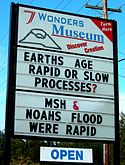Akron Fossils & Science Center

The Akron Fossils & Science Center is a small museum and learning center located in Copley Township, Ohio, United States, a few miles west of Akron. The building contains the Creation Education Museum, which features exhibits displaying the arguments for and against creationism and intelligent design, as well as an exploration of the relationship between science and the Bible. The building also houses several areas with interactive tour stations and activities focused on hands-on science. An outdoor park offers playground equipment and a 200 ft zip-line.
Throughout the year, the facility hosts a variety of educational programs. Some of the programming is targeted toward the religious base that supports the museum's creationist leanings, while many of the other programs maintain a straightforward, science-based approach. Activities like themed summer camps, presentations about fossilization, live animal shows, birthday parties, and Education Days take the more neutral approach. On the other hand, the center offers guided tours of the Creation Education Museum, as well as K-12 science classes, speaking engagements, and youth nights, all of which tend more towards the creationist approach. These programs are optional and are designed to promote pseudoscientific intelligent design theories in connection with the Judeo-Christian religious tradition.
History[]

It was opened May 26, 2005,[1] by William Sanderson II, a financial planner and former Cincinnati middle-school science teacher.[2] Sanderson has an MBA from Malone University in Canton, Ohio, and a BSc degree in education from Miami University in Oxford, Ohio.[3]
Since its opening, the facility has undergone several revisions and renovations to house its growing list of programming options. Fossilization presentations include hands-on experiences with dinosaur bones and eggs, permineralized teddy bears, and bivalve fossils, among other artifacts. Live animal interactions feature snakes, bearded dragons, guinea pigs, and sugar gliders.[4]
Inside the Creation Education Museum, topics covered include abiogenesis, Mount St. Helens, the Grand Canyon, and the Ice Age. The museum also touches on several controversial subjects, including microevolution vs. macroevolution, Ica stones, OOPArts, dragons, intelligent design theory, Noah's flood, and several core tenets of creationism.
Criticism[]
The scientific community considers creationism to be pseudoscience.[5][6] As a result, science organizations, such as the National Center for Science Education, criticize the promotion of creationism as a form of non-science.[7][8] Glenn Branch, deputy director of the NCSE explained "[The museum's] scientific claims are simply wrong and have been debunked long ago, and students who are misled by them are likely to be at a disadvantage as they study science at institutes of higher learning."[2]
References[]
- ^ "Creation Based Science Museum Opens Today", audio report by Vincent Duffy, May 26, 2005, WKSU. Retrieved August 20, 2008.
- ^ a b "Jurassic Lark" Archived 2008-08-21 at the Wayback Machine, by James Renner, June 6, 2007, Cleveland Free Times. Retrieved August 20, 2008.
- ^ "Malone college: 2005 Alumni Awards" Archived 2006-09-01 at the Wayback Machine, Malone University, 2006. Retrieved August 20, 2008.
- ^ "Guided Tours - Akron Fossils & Science Center", Akron Fossils & Science Center, 2018. Retrieved February 17, 2018.
- ^ Finding the Evolution in Medicine Archived 2008-11-22 at the Wayback Machine, Cynthia Delgado, NIH Record, July 28, 2006.
- ^ "Creationism in any of its forms, such as 'intelligent design', is not based on facts, does not use any scientific reasoning and its contents are pathetically inadequate for science classes.""The dangers of creationism in education". Council of Europe. Archived from the original on 13 August 2007. Retrieved 2007-08-03.
- ^ "Project Steve: FAQs". National Center for Science Education. 2008. Retrieved 2008-09-06.
- ^ Scott, Eugenie (2008). "Statements from Scientific Organizations". National Center for Science Education. Retrieved 2008-09-06.
External links[]
- Akron Fossils & Science Center official site
- 2005 establishments in Ohio
- Museums established in 2005
- Museums in Summit County, Ohio
- Creationist museums in the United States
- Religious museums in Ohio
- Science museums in Ohio
- Museums in Akron, Ohio

